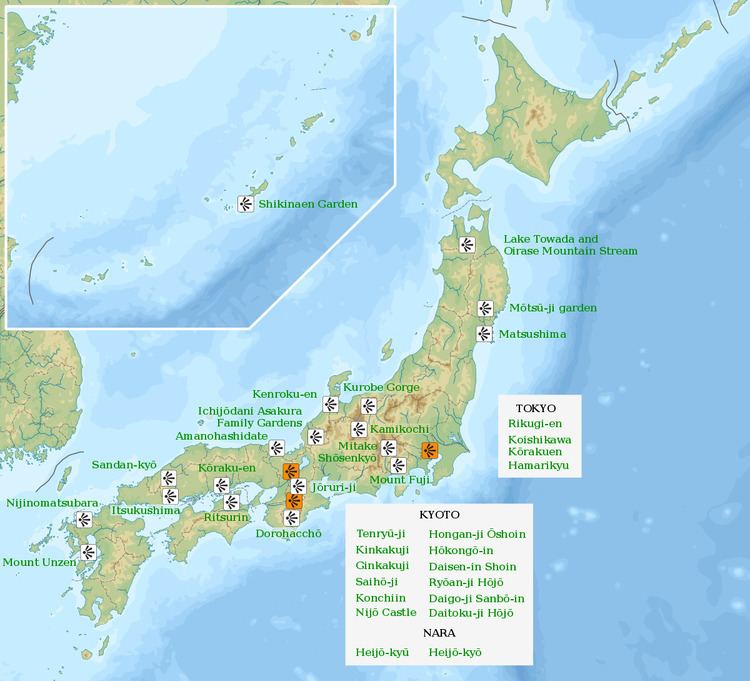 | ||
To protect Japan's cultural heritage, the country's government selects through the Agency for Cultural Affairs important items and designates them as Cultural Properties under the Law for the Protection of Cultural Properties. Designated items are classified in a number of categories, one of which is Monuments (記念物, kinenbutsu). This category includes historic locations such as shell mounds, ancient tombs, sites of palaces, sites of forts or castles, monumental dwelling houses and other sites of high historical or scientific value; gardens, bridges, gorges, mountains, and other places of great scenic beauty; and natural features such as animals, plants, and geological or mineral formations of high scientific value.
Contents
- Criteria
- Places of Scenic Beauty and Special Places of Scenic Beauty
- Historic Sites and Special Historic Sites
- Natural Monuments and Special Natural Monuments
- Usage
- References
The government further designates "significant" monuments classifying them in three categories: Historic Sites (史跡, shiseki), Places of Scenic Beauty (名勝, meishō), and Natural Monuments (天然記念物, tennen kinenbutsu). Items of particularly high significance receive higher classifications: Special Historic Sites (特別史跡, tokubetsu shiseki), Special Places of Scenic Beauty (特別名勝, tokubetsu meishō), and Special Natural Monuments (特別天然記念物, tokubetsu tennen kinenbutsu) respectively. As of April 1, 2016 there are 1,021 Natural Monuments, 1,760 Historic Sites, 398 Places of Scenic Beauty, 75 Special Natural Monuments, 36 Special Places of Scenic Beauty and 61 Special Historic Sites. Since a single item can fall under more than one of these categories, the total number of sites is less than the sum of designations.
Criteria
The Agency for Cultural Affairs designates monuments based on a number of criteria. A monument can be designated based on more than one of these criteria:
Places of Scenic Beauty and Special Places of Scenic Beauty
- Parks and gardens (公園、庭園)
- Bridges and embankments (橋梁、築堤)
- Flowering trees, flowering grass, autumn colors, green trees and other places of dense growth (花樹、花草、紅葉、緑樹などの叢生する場所)
- Places inhabited by birds and wild animals, fish/insects and others (鳥獣、魚虫などの棲息する場所)
- Rocks, caves (岩石、洞穴)
- Ravines, gorges, waterfalls, mountain streams, abysses (峡谷、瀑布、溪流、深淵)
- Lakes, marshes, wetlands, floating islands, springs (湖沼、湿原、浮島、湧泉)
- Sand dunes, spits, seasides, islands (砂丘、砂嘴、海浜、島嶼)
- Volcanoes, onsen (火山、温泉)
- Mountains, hills, plateaus, plains, rivers (山岳、丘陵、高原、平原、河川)
- Viewpoints (展望地点)
Historic Sites and Special Historic Sites
- Shell mounds, settlement ruins, kofun, other historic ruins of this type (貝塚、集落跡、古墳その他この類の遺跡)
- Ruins of fortified towns, castles, government administration offices, old battlefields and other historic ruins related to politics or government (都城跡、国郡庁跡、城跡、官公庁、戦跡その他政治に関する遺跡)
- Remains of shrines and temples, former compound grounds and other historic ruins related to religion (社寺の跡又は旧境内その他祭祀信仰に関する遺跡)
- Schools, research institutions, cultural facilities and other historic ruins related to education, learning or culture (学校、研究施設、文化施設その他教育・学術・文化に関する遺跡)
- Medical care and welfare facilities, life related institution, other society and life related historic ruins (医療・福祉施設、生活関連施設その他社会・生活に関する遺跡)
- Transport and communication facilities, forest conservation and flood control facilities, manufacture facilities and other historic sites related to finance or manufacture activities (交通・通信施設、治山・治水施設、生産施設その他経済・生産活動に関する遺跡)
- Graves and stone monuments with inscriptions (墳墓及び碑)
- Former residences, gardens, ponds and other areas of particular historical significance (旧宅、園池その他特に由緒のある地域の類)
- Ruins related to foreign countries or foreigners (外国及び外国人に関する遺跡)
Natural Monuments and Special Natural Monuments
- Animals (動物)
- Well-known animals peculiar to Japan and their habitat (日本特有の動物で著名なもの及びその棲息地)
- Animals which are not peculiar to Japan, but need to be preserved as well-known characteristic Japanese animals, and their habitat (特有の産ではないが、日本著名の動物としてその保存を必要とするもの及びその棲息地)
- Animals or animal groups peculiar to Japan within their natural environment (自然環境における特有の動物又は動物群聚)
- Domestic animals peculiar to Japan (日本に特有な畜養動物)
- Well-known imported animals presently in a wild state, with the exception of domestic animals; their habitat (家畜以外の動物で海外よりわが国に移殖され現時野生の状態にある著名なもの及びその棲息地)
- Particularly valuable animal specimen (特に貴重な動物の標本)
- Plants, vegetation (植物)
- Old trees of historic interest, gigantic trees, old trees, deformed trees, cultivated pulpwood, roadside trees, shrine forests (名木、巨樹、老樹、畸形木、栽培植物の原木、並木、社叢)
- Representative primeval forests, rare forest flora (代表的原始林、稀有の森林植物相)
- Representative alpine plants, special clusters of plants on rock ground (代表的高山植物帯、特殊岩石地植物群落)
- Representative clusters of waste land plants (代表的な原野植物群落)
- Representative examples of coastal and sand ground vegetation (海岸及び沙地植物群落の代表的なもの)
- Representative examples of areas of peat forming plants (泥炭形成植物の発生する地域の代表的なもの)
- Clusters of plants growing in caves or grottoes (洞穴に自生する植物群落)
- Rare water plants in garden ponds, onsen, lakes, marshes, streams, sea, etc.; algae, moss, microbes, etc. (池泉、温泉、湖沼、河、海等の珍奇な水草類、藻類、蘚苔類、微生物等の生ずる地域)
- Remarkable occurrence of epiphytic plants on rocks, trees or shrubs (着生草木の著しく発生する岩石又は樹木)
- Remarkable plant growth on marginal land (著しい植物分布の限界地)
- Remarkable growth in the wild of crop plants (著しい栽培植物の自生地)
- Wild habitat of rare or near extinct plants (珍奇又は絶滅に瀕した植物の自生地)
- Geological and mineralogical features (地質鉱物)
- Rocks, mineral and fossil producing sites (岩石、鉱物及び化石の産出状態)
- Conformable and unconformable strata (地層の整合及び不整合)
- Fold and thrust strata (地層の褶曲及び衝上)
- Geological features caused by the work of living creatures (生物の働きによる地質現象)
- Phenomena related to earthquake dislocation and landmass motion (地震断層など地塊運動に関する現象)
- Caves, grottoes (洞穴)
- Examples of rock organization (岩石の組織)
- Onsen and their sediments (温泉並びにその沈澱物)
- Erosion and weathering related phenomena (風化及び侵蝕に関する現象)
- Fumaroles and other items related to volcanic activity (硫気孔及び火山活動によるもの)
- Ice and frost related phenomena (氷雪霜の営力による現象)
- Particularly precious rock, mineral and fossil specimen (特に貴重な岩石、鉱物及び化石の標本)
- Representative territories rich in natural monuments to be protected (Natural Protected Areas) (保護すべき天然記念物に富んだ代表的一定の区域(天然保護区域))
Usage
The table's columns (except for Remarks and Photo) are sortable pressing the arrows symbols. The following gives an overview of what is included in the table and how the sorting works.
